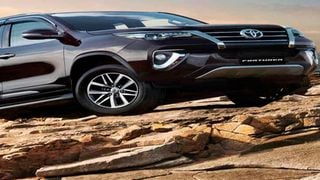
Toyota Fortuner .
| PoolDN2
Premium
Good enough for the city, good enough for the village
Dear Baraza JM,
Please, allow me to thank you for the good work that you are doing. I always look forward to reading your motoring column every Wednesday.
I wish to buy a SUV for my use from Rongai ''diaspora'' to Nairobi CBD daily with a once in a month trip to Nyamira County. Please compare and contrast the Toyota Fortuner, the Toyota Rav4 and the Subaru Forester in terms of reliability, off road capability, fuel consumption, and advice. Resell value is not a factor.
Sincerely,
Mogeni Ong'era
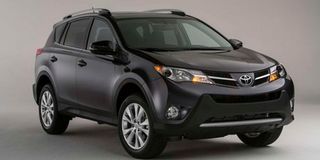
Toyota Rav4.
Hi Ong'era,
Let me just say that of these three cars, one is not like the others, and no, it is not the Subaru I am referring to even though the rest are Toyotas. It is the Fortuner. It is a body-on-frame seven-seat SUV while the others are five-seat monocoque crossovers. Aaanyway...
Reliability favours the out-of-place kid in the class, the Fortuner, because it is a Toyota. "But the Random Access Vehicle is a Toyota too, what's the difference?" you ask. The Fortuner is a 4WD vehicle built to do 4WD stuff so it has to be built tough (sorry, Ford) for it to last longer under harder use. The RAV is an urban assault vehicle that is not driven anywhere more dangerous than a shopping mall parking lot or on missions riskier than a school run. Softie, that one. The Forester is well known for having weak stabiliser links and a nonsensical electric system for power assistance in the steering.
Off-road capability of course favours the overgrown kid again. Big, chunky wheels, high ground clearance, non-existent overhangs, selectable 4WD with low range and locking rear diff... it has the full kit and caboodle that the rest possess none of. The Forester has been spotted pretending to go off-road but really, there is no contest here.
Fuel consumption: guess what? The Fortuner wins again, sort of, because there are disclaimers here. First, it has to be diesel powered. Petrol Fortuners are thirsty like hell. Secondly, it has to be the second generation. First generation Fortuners are not very impressive fuel-wise, even with Toyota's venerable KD engines under the bonnet. Third, it has to be an automatic, preferably with Toyota's Super ECT-i transmission programming overseeing the cog-swapping protocols.
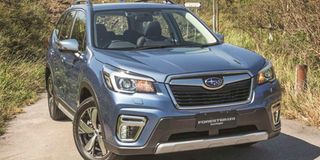
Subaru Forester.
Advice: get the RAV4. Surprised? Don't be. Despite the Fortuner winning all three criteria you listed, and it being our 2018 Car of The Year here at the Motoring Press Agency, the Fortuner is also what we call "unnecessary". Do you really need that much car? You see, the Fortuner is a seven-seat 4WD vehicle and it's best if you use those capabilities as they have been engineered into the vehicle. Do you need seven seats? No. Do you need off-roading capability of the billy goat kind? No. Do you need a Fortuner? No, it is unnecessary.
Get the RAV4 (sorry Subaru, but the RAV edges forward on dependability despite losing ground to the Forester on almost every other aspect)
A long and comprehensive answer for a young car enthusiast…
Hi Baraza,
I am a frequent reader of your column. I am a student at Mang’u High School, ambitious about cars and taking power mechanics as a subject. It goes without saying that some motor vehicle components are becoming obsolete including the very heart, the internal combustion engine.
Here is my question, for the duration ICEs are with us, do you anticipate manual transmission gearboxes to be phased out? I mean, hey, I too would like a piece of the fun that comes with having full control of torque output.
Victor Ikua.
Hello Victor,
Always glad to encounter a young enthusiast, and all the best with Power Mechanics, I got an A in that back at Alliance High School many eons ago.
Now, you are right, certain aspects of the motor vehicle are very quickly becoming obsolete, starting with the internal combustion engine... but hold on a minute. You asked about the manual transmission being phased out. Well, the manual transmission is already obsolete for the most part, and its death slump started long before the internal combustion engine was even considered for retirement.
The manual transmission started dying out early this century. The main reason for this was a dwindling market, led by the Americans. As the numbers of automatics continued swelling, other “non-manual” transmission types also gained foothold, mainly CVTs (continuously variable transmissions) and DSGs (dual-shift or direct-shift gearboxes).
These two transmissions took the advantages that manual transmissions had over automatic and chucked them in the skip: CVTs can attain incredible fuel economy figures and should ideally be maintenance-free depending on design, though in reality, both these qualities are highly theoretical and are not always observable. DSGs on the other hand have shift times unattainable by the human hand, so when it comes to swapping cogs, the human speed enjoyed by the manual transmission has now been conquered by a machine.
Automatics, by virtue of demand, have also come a long way such that certain manufacturers, especially those of performance marques, are reverting to them, back from the quick-shifting dual-clutch transmissions that made waves about a decade ago. Then there is the millennial, born when the internet existed, corporal punishment was frowned upon and automatic transmissions were mainstream.
They do not understand the concept of delayed gratification nor do they appreciate the sweetness of struggle. The Google generation likes instant results and this easy-way-out attitude extends to their driving habits. For them, there is no point shifting your own gears when your transmission control module can do it for them. Theirs is a life full of automation, from everyday conveniences to everyday conveyances.
As we speak, very few manufacturers offer manual transmissions in their passenger cars. It is not easy coming up with a comprehensive list because an American car website will talk about vehicles offered in their market, European car websites don’t really care about such lists and Asian car websites focus on statistics.
African car websites are too busy declaring every car the best in its class. Then there are the Chinese. However, it should say something when the only performance brand still offering manual transmissions is Porsche, while the only truck tractor and bus manufacturers offering manual transmissions are Japanese and Chinese. Manual transmission is dead.
My Mercedes Benz C180 looks perfect on the outside, but is seriously ailing on the inside
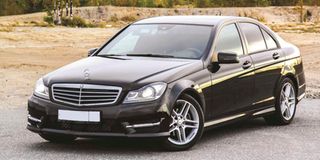
Mercedes-Benz C-180.
Hi Doc,
You are really good at what you do and I must admit I envy your motoring skills though in a very positive way.
A few days ago I had sought your wisdom on image budget cars. True to your counsel, I picked a 2007 Mercedes Benz C180 which looked very well maintained on the outside.
Three days into use, the thing started to sputter in the morning when I switched the ignition on, and produced very dark smoke in sputters. It jerks violently then switches off itself. When I turn it on after a few minutes, the car picks as smooth as new. I must admit that I fear taking the thing from the parking lot since it may die in the middle of Thika Highway, which has no lane. You can park your car aside as you wait for help.
Note that I did a full service with genuine products. How can I find the cure?
Asanti Doctari
Hello,
Dark smoke and sputtering can only mean one thing: the vehicle is not burning fuel properly, which is indicative of a weak spark or none at all. That right there is the point at which you should start your troubleshooting: the spark plugs.
If they’re not at fault, continue working your way upstream along the ignition system: the leads. Check them for integrity, cracked insulation could cause arcing, there could be wear and tear in the form of chafing or even intermittent disconnection via frayed wiring. There are a few other things to check such as the oxygen sensors, the MAF sensor, vacuum leaks, exhaust leaks and such, but these are usually accompanied by a Check Engine Light, for which a diagnosis is required to narrow down the problem area. Your air filter could also be clogged.
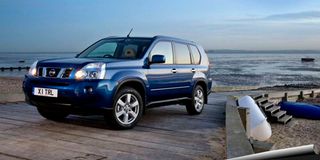
Nissan X-Trail.
Surely, Nissans can’t be that bad, my wife and I own one each, and we’re not complaining...
Mr Barasa
You have picked out several of my emails to you in the past, so I’ll be reserved in my praise for the unnamed person who went all samurai on you in defense of Nissan on September 8th, 2021. Serves you right!
After going through several vehicles in my car's history, I now drive a 2009 Nissan X Trail(T31) acquired in 2014 with 45,000 Kms on the odometer (highly suspect!). It now reads 213,000. My better half has a similar vehicle, though with more bells and whistles.
Suffice to say, the vehicles have served us quite well over the years, literally trouble free. I’ve driven my humble one through Tanzania and Zambia through to Windhoek then onto Gaborone through the Trans Kalahari highway trouble free. And back.
Yes, along the highway, Prados, M Class Mercedes and BMW’s were whizzing past me like I didn’t exist, but I got back in one piece. The only breaks in the trip were to eat, sleep and refuel. Now, Nissan’s can’t be that bad, can they?
Good day
Patrick.
You are right, Nissans can’t be that bad... and some of them aren’t, the operational word here being “some”. Some Nissans are excellent and class-leading. Insert the Patrol and GTR in this slot. Some are middling, and this is where your X-Trail lies, along with the Skylines and Navaras (current generation). Probably the current NV350 Caravan occupies this space too. Then some are not worth it, like the Note and the E25 Caravan with its poorly thought out ZD30 turbodiesel. There is also the Sylphy with its melting dashboard.
Some Nissans look good (Skyline, Patrol facelift), some have good interiors (anything with an Infiniti badge, Skyline) some have so-so interiors (Navara) and some have unattractive interiors (anything from the 2000s - 2010s with a beige interior). So they run the whole gamut.
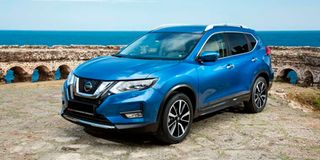
Nissan X-Trail
Your car came for the Great Run 19, and its occupants praised it to no end. It was a white, diesel-powered T31 with a manual transmission, a rare permutation, and the fellows who drove it sang its praises, but then again one of them already owns another Nissan (Tiida) so I could claim observer bias, while the other owns a Range Rover Classic with a 3.5 liter carb-fed V8, which means he needs prayers.
Also, come on, exercise some creativity in your household. Lose one of the T31s and get something else. A man running alone thinks he runs fastest and a child always thinks its mother’s cooking is the best. Expose yourselves to something else, you may discover some automotive wonders out there...
Forget it, tipping your car won’t get more fuel into it

Pump attendant fueling a vehicle at Shell Petroleum Station on Kenyatta Avenue in Nairobi on Wednesday, April 14, 2021.
Dear Baraza,
I have always wondered whether motorists who, when fueling at the pump, cajole, shake or even try to lean their vehicles over by stepping on metal platforms know something we don’t! I get concerned when, especially Matatu drivers, keep on shaking the vehicle to ensure that it is completely full! Are the tanks not designed to have some ‘breathing’ space?
Hello,
I did address this some time back and declared it a pointless exercise. I don’t think it bears repeating, but I will repeat it anyway:
Shaking does not liberate any more space than already existed before, and even if it did, the space is insignificant at best and what little extra fuel you will squeeze in there will make no difference whatsoever since you will still refuel when you run low, most probably with that “extra” fuel still in the tank. Shaking the vehicle will not improve fuel consumption nor will it make fuel cheaper. It is what we call a Chinese fire drill: an exercise in which much energy is expended to achieve exactly nothing.





